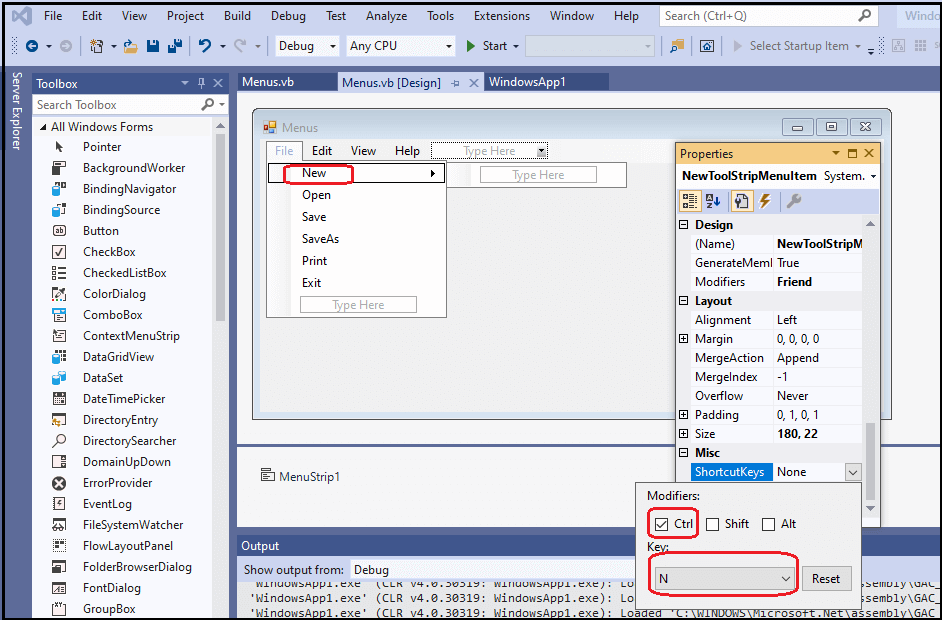
- #Menustrip conventions how to#
- #Menustrip conventions upgrade#
- #Menustrip conventions code#
- #Menustrip conventions windows#
In the Items Collection Editor dialog box, add a new ToolStripMenuItem named ChildMenuItem to the child menu.įor more information, see ToolStrip Items Collection Editor.Ĭlick the Window menu item to open the menu, and then click New.Ī new child form is created in the form's MDI client area.
#Menustrip conventions windows#
The menu items for this form are merged with those of the parent form.Īdd a new form named ChildForm to the project.įor more information, see How to: Add Windows Forms to a Project.įrom the Toolbox, drag a MenuStrip control onto the child form.Ĭlick the MenuStrip control's designer actions glyph ( ), and then select Edit Items. In this procedure, you will define a separate child form class that has its own MenuStrip control. The ToolStripPanel control appears in the Toolbox. Select the check box by ToolStripPanel, and then click OK. In the Choose Toolbox Items dialog box, scroll down the Name column until you find ToolStripPanel. Right-click to open the shortcut menu, and select Choose Items. Open the Toolbox, and then click the All Windows Forms tab to show the available Windows Forms controls. You must add the ToolStripPanel control to the Toolbox to build your MDI form in the Windows Forms Designer. When you use MenuStrip controls with an MDI form you must have the ToolStripPanel control. Private Sub newToolStripMenuItem_Click( _į.Text = "Form - " + Me.()Īdd the ToolStripPanel control to the Toolbox ' and attaches it to the MDI parent form. ' This method creates a new ChildForm instance Private void newToolStripMenuItem_Click(object sender, EventArgs e)į.Text = "Form - " + () and attaches it to the MDI parent form. This method creates a new ChildForm instance
#Menustrip conventions code#
Insert the following code into the event handler. The Windows Forms Designer generates an event handler for the Click event. In the Properties window, set the value of the MdiWindowListItem property to ToolStripMenuItem1.Īdd a subitem to the Window menu item, and then name the subitem New. Menu items from child forms are merged into the main menu.įrom the Toolbox, drag a MenuStrip control onto the form.Īdd a ToolStripMenuItem to the MenuStrip control and name it Window. With the Window menu item, you can create child forms. The main menu has one menu item named Window. The parent MDI form contains the main menu.

In the Properties window, set the value of the IsMdiContainer to true. In the Windows Forms Designer, select the form. In Visual Studio, create a Windows Application project called MdiForm ( File > New > Project > Visual C# or Visual Basic > Classic Desktop > Windows Forms Application). You'll need Visual Studio to complete this walkthrough. To copy the code in this topic as a single listing, see How to: Create an MDI Form with Menu Merging and ToolStrip Controls. When you are finished, you will have an MDI form that supports menu merging and movable ToolStrip controls. The actual name of the menu will vary.Īdding the ToolStripPanel control to the Toolbox.Īrranging ToolStripPanel controls by z-order. The following tasks are illustrated in this walkthrough:Ĭreating the main menu for your form. The form also supports menu merging with child menus.

#Menustrip conventions how to#
This walkthrough demonstrates how to use ToolStripPanel controls with an MDI form. In a project context, we would further customize the rules so that various customer-specific requirements are automated such as other Wisej/.NET standards.The namespace supports multiple document interface (MDI) applications, and the MenuStrip control supports menu merging.
#Menustrip conventions upgrade#
In an actual upgrade solution, I would create a generalized Wisej upgrade configuration that could be used with many different VBPs and code files and also develop a set of rules files to deal with third-party controls.




 0 kommentar(er)
0 kommentar(er)
